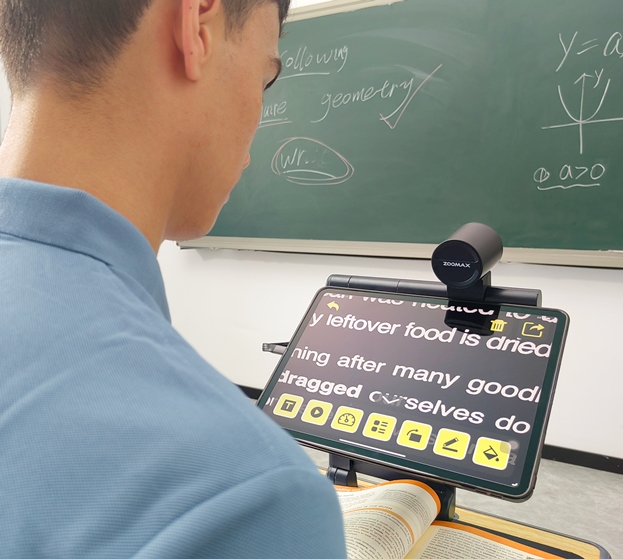For the estimated 285 million people worldwide living with low vision, the daily act of reading a menu, recognizing a friend’s face, or even checking a text message can feel like climbing a mountain. Vision loss doesn’t just alter how we see the world—it reshapes how we feel about ourselves, our independence, and our place in life. What many overlook, though, is how the right tools—from a simple magnifying glass to a sophisticated digital magnifier—can ease both the practical and emotional burdens of low vision. Let’s explore the hidden mental health toll of vision loss and how accessible aids like magnifiers are more than just devices—they’re lifelines to confidence and connection.
The Silent Toll: How Vision Loss Hits Mental Health
Vision is tied to nearly every part of our daily routine. When it fades, even small tasks become overwhelming. Imagine sitting down to read a book, only to squint at blurry text and realize you need a magnifying glass—but it’s nowhere to be found. Or trying to send a quick email, fumbling with your phone because you can’t see the keys, and thinking, “I should find a magnifying glass for my phone.” These moments aren’t just frustrating—they chip away at self-esteem.

Studies consistently link low vision to higher rates of anxiety and depression. For many, vision loss means losing independence: you can’t drive to the grocery store alone, you need help sorting mail, or you hesitate to join social gatherings because you’re worried about missing cues or embarrassing yourself. Loneliness creeps in when you stop going out, and self-doubt grows when tasks that once took minutes now take hours. A 2023 survey by the World Health Organization found that adults with low vision are 30% more likely to report symptoms of depression than those with full vision—often because they feel powerless to manage their own lives.
Take Maria, a 62-year-old retired teacher with age-related macular degeneration (AMD). “I used to love reading to my grandchildren,” she says. “Now, I can barely make out the words in their picture books. I’d sit there, pretending I could see, but I’d get so anxious I’d make up stories instead. Eventually, I stopped asking them to come over—I didn’t want them to see me struggle.” Maria’s story is common: low vision often makes people withdraw, not because they want to, but because they fear being a burden or feeling inadequate.
The Role Of Magnifiers: More Than Just “Seeing Better”
When Maria finally tried a portable digital magnifier, something shifted. “It was a small 5-inch one—light enough to hold in my hand,” she says. “Suddenly, I could read the book again. My grandson looked at me and said, ‘Grammy, you’re smiling!’ I didn’t realize how much I’d stopped doing that.”
Magnifiers aren’t just tools for clarity—they’re tools for reclaiming control. For low vision individuals, having access to the right magnifying glass or electronic magnifier turns “I can’t” into “I can.” Let’s break down the most common options and how they ease mental strain:
1. Basic Magnifying Glasses: Simple, But Powerful
A traditional magnifying glass is often the first tool people reach for, and for good reason. It’s affordable, portable, and perfect for quick tasks—like reading a price tag, checking a pill bottle label, or reading a letter. For someone who’s just starting to notice vision changes, finding a reliable magnifying glass can reduce the panic of “losing” their ability to do small, daily things. Even better, many come with built-in lights (digital magnifying glass with light) for dim spaces, making tasks easier without added stress.

2. Phone And Android Magnifiers: Convenience In Your Pocket
In a world where we carry our phones everywhere, magnifying glass on phone or magnifier on Android tools are game-changers. Most smartphones have built-in magnifiers (try searching “android magnifying glass” in your settings), and some magnifier apps offer even more features—adjustable zoom, contrast settings, and even text-to-speech. For someone like Maria, who loves staying connected via text, a magnifying glass for my phone means she no longer has to ask her daughter to read messages. “I can text my friends back on my own now,” she says. “It sounds small, but it makes me feel like myself again.”
3. Digital And Electronic Magnifiers: Precision For Daily Life
For more intensive tasks—like reading a newspaper, working on a hobby, or studying—digital magnifiers and electronic magnifiers shine. These devices use cameras and screens to enlarge text or objects, often with better clarity than traditional glass. Options range from handheld models (handheld digital magnifier, portable electronic magnifier) to desktop versions (desktop electronic magnifier) for home use. The CCTV magnifier (closed-circuit television) is a popular choice for reading: it displays enlarged text on a screen, reducing eye strain and making long reading sessions manageable.
Brands like Eschenbach (Eschenbach electronic magnifier) and Zoomax (Snow 12 magnifier) are known for their user-friendly designs, and many are available on platforms like Amazon (electronic magnifier Amazon) for easy access. For people who love to read, a digital magnifier for reading or electronic reading magnifier can reignite a passion that vision loss nearly stole. “I used to read two books a week,” says James, 58, who has glaucoma. “After I lost my central vision, I stopped. Then I got a portable digital video magnifier—now I’m back to my old habit. It’s not just about the books; it’s about feeling like I’m still growing, still learning.”
Breaking The Stigma: Why Access To Magnifiers Matters For Mental Health
Despite the benefits, many people with low vision hesitate to use magnifiers. Stigma plays a big role: some see them as a “sign of weakness” or worry they’ll be judged. Others don’t know what tools are available—they might not realize their phone has a built-in magnifying glass on Android phone, or that a mobile magnifying glass can fit in their pocket.
This hesitation comes at a cost. When people avoid using magnifiers, they’re more likely to isolate themselves, feel frustrated, and spiral into anxiety. The solution? Normalizing these tools. Magnifiers are no different from glasses—they’re just aids to help us function. And when people start using them openly, they not only improve their own mental health but also help others feel more comfortable seeking help.
Healthcare providers can also play a role. Too often, eye doctors focus on treating the physical aspects of vision loss (like prescribing glasses) but forget to discuss low vision aids. A simple conversation—“Have you tried a digital magnifying glass?” or “Did you know your phone has a magnifier?”—can change someone’s life. For Maria, it was her optometrist who suggested a ruby digital magnifier. “I had no idea those existed,” she says. “Now, I can read recipes again. Cooking was my favorite thing—now I’m back in the kitchen, and my family notices the difference in my mood.”
Hope Through Adaptation: Thriving With Low Vision
Vision loss is a journey, but it doesn’t have to be a lonely one. The key to protecting mental health is adaptation—and that starts with the right tools. A magnifying glass might seem like a small thing, but it’s a symbol of resilience: it says, “I’m not letting this stop me.”

Whether you’re using a basic magnifying glass, a phone app, or a high-tech electronic magnifier, the goal is the same: to stay connected to the people and activities you love. For James, that means reading to his granddaughter. For Maria, it means cooking Sunday dinners. For countless others, it means walking into a store and knowing they can read a price tag on their own.
If you or someone you love is living with low vision, remember: you’re not alone. Start small—download a magnifier on Android app, borrow a portable digital magnifier from a low vision center, or ask your doctor for recommendations. Every step you take to reclaim your independence is a step toward better mental health.
Vision loss changes how you see the world, but it doesn’t have to change who you are. With the right tools—and a little hope—you can keep doing the things that make you you. After all, seeing clearly isn’t just about the eyes—it’s about the heart.



